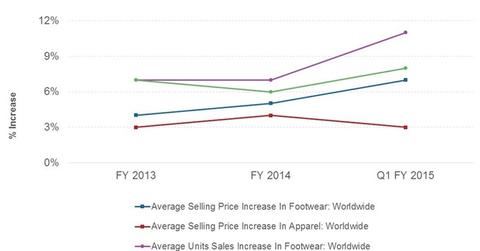Understanding NIKE’s Pricing Power And Premium Products Tilt
Innovation and strong consumer demand enable NIKE to add more premium products to its portfolio. But its price-hiking strategies may not work everywhere.
Nov. 20 2020, Updated 11:30 a.m. ET

An overview of NIKE’s pricing strategies
Being able to charge higher prices for its products is one of the key differentiators for NIKE. Over the past few years, the company has clocked in selling price increases in most markets and categories as it pushes the boundaries of brand premiums ever further.
Brand power
NIKE (NKE) is ranked the #1 sports brand in “The Forbes Fab 40: The World’s Most Valuable Sports Brands 2014.” With its strong brand image, tradition of introducing innovative products to the marketplace, current product stable, and high-profile endorsements from world-class athletes, the company has positioned its products at the higher price points in the market.
Selling price increases
Average selling prices for footwear increased by an average of 5% worldwide and 4% in North America in fiscal 2014. Apparel selling prices increased by 4% in both geographies. Despite the increases, the company recorded market share gains in the key footwear and apparel categories in the US and abroad, as we learned in Parts 4 and 5.
In 1Q15, worldwide average selling prices rose by 7% for footwear and 3% for apparel. Footwear in North America increased even more, by 9%. Apparel prices climbed 3%. Despite the increases, worldwide unit sales rose, growing by 11% and 8%, respectively. The company expects to continue raising prices for the remainder of fiscal 2015.
Footwear at above-average prices
In 2013, a pair of running shoes in the US retailed at an average price of $66.85.[1. National Sporting Goods Association] Although NIKE has some products in the lower price range, it’s seen most of the category growth in premium footwear models—those retailing for $100 and above.
Discretionary consumption increases
The higher prices in upper price ranges are symptomatic of an improving labor market and higher expenditures on discretionary consumer goods. For example, NIKE commands a 97% share of the US footwear market in basketball. Of all shoes sold in the five weeks through December 6, 2014, 50% cost $100 and above. In contrast, the figure was just 35% in the five weeks ending December 8, 2012.[1. The NPD Group, Footwear POS Weekly 2012-14]
Besides new and innovative product launches, star-athlete endorsements and brand power, NIKE’s performance is also being helped along by improving US macroeconomic fundamentals, as we learned in Part 2 of this series. People tend to spend more on high-end products when they’re confident in their jobs and prospects.
Outlook
Going forward, the company expects to continue its price-hiking strategies. For example, keeping up a stream of product innovations will enable NIKE to level higher premiums. The company filed as many as 540 patents in 2013 alone. It’s also likely to add more premium products to its apparel portfolio. These will probably result in both top-line and margin improvements.
Having said this, NIKE does face the risk of growth slowdowns in key markets including Europe, Japan, and Brazil, as you’ll discover in Parts 14 and 15. And such slowdowns may impact its ability to execute price-hiking strategies across the board.
